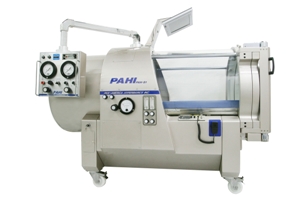As concussions in sports become an increasingly prevalent issue, it is important for parents to know how they can help their child recover from concussions, regardless of its severity. Hyperbaric Oxygen Therapy is one of the lowest-risk treatments available, and a good way to be proactive about helping a child suffering from post-concussion syndrome return to the classroom and playing field. 
In a study by Dr. Paul Harch, [1] one of the leading doctors in hyperbaric medicine, fifteen military personnel (all previously diagnosed with traumatic brain injury) were treated with forty hyperbaric oxygen treatments. Each patient made significant improvements in injury symptoms, physical exam results, cognitive measurements, and most importantly, quality of life ratings.
No physical injury can heal without oxygen, and the same applies for the brain. Hyperbaric oxygen therapy allows a patient to breathe 100% oxygen (as opposed to air from the atmosphere, which is 21% oxygen and 79% nitrogen) in a pressurized chamber, which creates a higher concentration of oxygen in the bloodstream, which can improve circulation to impaired brain areas.
An article from the Division of Neurosurgery at Linda Loma University Medical Center [2] acknowledges that many brain injuries result in reduced blood supply to affected tissues, which can impair brain function. Increasing the concentration of oxygen in the bloodstream can help repair damaged tissue, and reduce swelling and inflammation.
Typically, the standard approach for treating sports concussions involves a great deal of waiting. Concussed individuals are told to get cognitive rest and not over-stimulate the brain by using the phone and computer. After a concussion, athletes frequently complain of headaches and insomnia, and often privately struggle with anxiety, depression, and poor academic performance due to impaired brain function. Standard treatments may also involve medication, which can produce undesirable side effects.
Thankfully, hyperbaric oxygen therapy is highly effective and has minimal side effects. By comparing the risks of treating versus not treating your child for a concussion, it becomes clear that being proactive is essential. While concussion symptoms may improve through simply resting, they could also worsen. As you think about your athlete's post-concussion treatment, ask yourself: are you and your child willing to deal with persistent effects of head injury?
While the short term symptoms of concussions such as dizziness and headaches may not seem serious, long term problems such as dementia-like symptoms and advanced aging of brain tissue are not to be taken lightly. Brain injuries that go untreated have also been linked to learning disabilities, social and relationship issues, low self-esteem, depression, and alcoholism. What we see as headaches now could present themselves as problems that are serious and difficult to treat in the future.
Although no healthcare facility can promise a cure for concussion symptoms, hyperbarics can provide help to many people, from athletes with minor head injuries to soldiers involved in IED explosions. Our hope is that in the future, hyperbaric oxygen therapy will come to be seen as a low-risk, effective procedure that can help improve many symptoms of head trauma.
[Editor's Note: The value of hyperbaric oxygen therapy in treating post-concussion syndrome is controversial, with a recent double-blind, randomized, prospective study [3] of the effects of 2.4 atmospheres absolute hyperbaric oxygen on post-concussion symptoms in 50 military personnel with at least one combat-related mild traumatic brain injury finding no significant effect.]
Grace Van Scoyk is a Management Studies and Psychology double major at Gettysburg College in Pennsylvania. She is currently a Marketing Intern at Bethesda Hyperbaric Oxygen Therapy near Washington, DC.
Footnotes:
1. Harch P, et al. A Phase I Study of Low-Pressure Hyperbaric Oxygen Therapy for Blast-Induced Post-Concussion Syndrome and Post-Traumatic Stress Disorder. J Neurotrauma. 2011; DOI:111122062711007.
2. Calvert J Cahill J, Zhang J. Hyperbaric Oxygen and Cerebral Physiology. National Center for Biotechnology Information. U.S. National Library of Medicine, 2007. (accessed June 6, 2013).
3. Wolf G, Cifu D, Baugh L, Carne W, Profenna L. The Effect of Hyperbaris Oxygen on Symptoms after Mild Traumatic Brain Injury. J Neurotrauma 2012;29:2606-2612.
Posted June 10, 2013; updated September 13, 2013 to include the Editor's Note.








